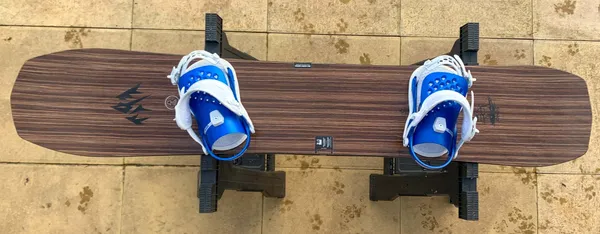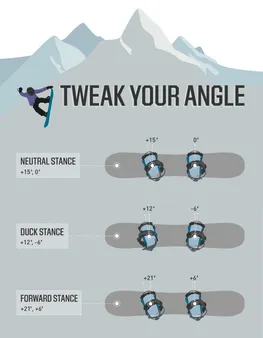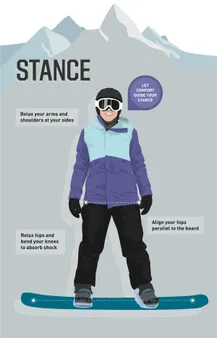Table of Contents
Snowboarding is an exhilarating winter sport that offers a thrilling experience on snowy slopes. Mastering the art of snowboarding starts with understanding How to do a snowboard stance. This comprehensive guide from Kizworld will take you through the steps of choosing the right stance, setting it up, adjusting it, and riding in it. Whether you're a beginner or looking to improve your skills, this guide will provide you with the knowledge and techniques you need to enhance your snowboarding experience.
How to Do a Snowboard Stance: A Comprehensive Guide for Beginners
I. Stand sideways on the snowboard
Stand sideways on the snowboard
Once you have your snowboard on, you need to stand sideways on it. Your dominant foot should be in front, and your other foot should be behind it. Your knees should be bent and your weight should be evenly distributed between both feet.
To help you balance, you can hold onto the toe strap with your front foot and the heel strap with your back foot. You can also use your arms to help you balance. Keep your arms out to the sides and slightly bent.
- Stand with your dominant foot in front and your other foot behind it.
- Bend your knees and distribute your weight evenly between both feet.
- Hold onto the toe strap with your front foot and the heel strap with your back foot.
- Keep your arms out to the sides and slightly bent.
Once you are comfortable standing sideways on the snowboard, you can start to move. To do this, you will need to use your edges to push yourself forward. To do this, simply press down on the edge of the snowboard with your front foot and lift up on the edge of the snowboard with your back foot.
As you push yourself forward, you will start to move. You can control your speed by how hard you press down on the edges of the snowboard. The harder you press, the faster you will go.
To stop, simply release the pressure on the edges of the snowboard. You will then come to a stop.
Tip | Description |
Start on a gentle slope. | This will help you get used to the feeling of snowboarding and build your confidence. |
Wear a helmet. | This is essential for safety. |
Dress in layers. | This will help you stay warm and dry. |
Take lessons from a qualified instructor. | This is the best way to learn the basics of snowboarding and improve your skills. |
Be patient. | It takes time to learn how to snowboard. Don't get discouraged if you don't get it right away. |
Snowboarding is a great way to get exercise and enjoy the winter weather. With a little practice, you can be snowboarding like a pro in no time.
Here are some additional tips for standing sideways on the snowboard:
- Keep your weight centered over the board.
- Don't lean too far forward or back.
- Keep your knees bent and your arms relaxed.
- Look in the direction you want to go.
- Don't be afraid to fall. Everyone falls when they are first learning to snowboard.
With a little practice, you will be able to stand sideways on the snowboard with confidence. Once you have mastered this, you can start learning how to move and turn.
If you are new to snowboarding, it is important to start out on a gentle slope. This will help you get used to the feeling of snowboarding and build your confidence. Once you are comfortable on a gentle slope, you can start to move on to more challenging terrain.
Snowboarding is a great way to get exercise and enjoy the winter weather. With a little practice, you can be snowboarding like a pro in no time.
How to Choose the Right Snowboard StanceHow to Set Up Your Snowboard StanceHow to Adjust Your Snowboard StanceHow to Ride in a Snowboard StanceTips for Riding in a Snowboard Stance
II. Bend your knees in a comfortable position
Bend your knees in a comfortable position
Once you have your feet in the right position, you need to bend your knees in a comfortable position. This will help you to absorb the shock of landing and to keep your balance. The amount of bend you need will depend on your personal preference and the terrain you are riding on. If you are riding on a hard surface, you will need to bend your knees more than if you are riding on a soft surface. You should also bend your knees more if you are going to be landing from a jump or if you are going to be riding over obstacles.
Here are some tips for bending your knees in a comfortable position:
- Keep your knees aligned with your toes.
- Don't let your knees go too far forward or too far back.
- Bend your knees just enough to absorb the shock of landing.
- If you are going to be landing from a jump or riding over obstacles, bend your knees more.
Once you have found a comfortable position for your knees, you can start riding. Remember to keep your weight centered over your board and to keep your eyes focused on where you are going. With a little practice, you will be able to ride a snowboard with ease.
Here are some related posts that you may find helpful:
- How to Choose the Right Snowboard for Your Skill Level and Style
- The Benefits of Snowboarding for Fitness and Fun
- The Best Snowboarding Equipment and Accessories
Stance | Description |
Regular | Left foot forward, right foot back |
Goofy | Right foot forward, left foot back |
Duck | Both feet angled outward |
Switch | Riding with your opposite foot forward |
Here are some additional tips for riding a snowboard:
- Start on a gentle slope.
- Take lessons from a qualified instructor.
- Wear a helmet and other protective gear.
- Be aware of your surroundings.
- Have fun!
III. Angle your feet slightly
Angle your feet slightly
Once you have your bindings set up, you need to angle your feet slightly. This will help you to control your board and make turns more easily. The amount of angle you need will depend on your personal preference, but a good starting point is to angle your front foot about 15 degrees and your back foot about -15 degrees.
Lean forward slightly
- Place your feet shoulder-width apart.
- Bend your knees and ankles slightly.
- Your weight should be distributed evenly between your front and back feet.
Riding Style | Stance Width | Advantages | Disadvantages |
Freestyle | Narrow (18-20 inches) | Increased maneuverability | Less stability |
All-Mountain | Medium (20-22 inches) | Good balance of maneuverability and stability | Not as specialized as other stances |
Freeride | Wide (22-24 inches) | Increased stability | Less maneuverability |
Keep your knees bent
- Bending your knees will help you to absorb shock and maintain control of your board.
- Don't lock your knees, as this will make you more likely to fall.
Now that you know how to do a snowboard stance, you're ready to hit the slopes! Just remember to take it easy at first and gradually increase your speed as you get more comfortable. With a little practice, you'll be snowboarding like a pro in no time.
How to Choose the Right Snowboard for Your Skill Level and Style
IV. Tips for Riding in a Snowboard Stance
- Start slowly and gradually increase your speed as you get more comfortable.
- Keep your weight centered and your knees bent.
- Use your arms to help you balance and control your board.
- Look ahead and be aware of your surroundings.
- Don't be afraid to fall. Everyone falls when they're first learning to snowboard.
With a little practice, you'll be snowboarding like a pro in no time!
The Best Snowboarding Equipment and Accessories
V. Distribute your weight evenly
Distribute your weight evenly
Proper weight distribution is crucial for maintaining balance and control on your snowboard. Aim for an equal distribution between your front and back foot, with slightly more weight on your front foot for better control and steering. This balanced stance will help you maintain stability and responsiveness as you navigate different terrains and conditions. Uneven weight distribution can lead to imbalances, loss of control, and increased risk of falls.
Here are some tips for distributing your weight evenly:
- Stand with your feet shoulder-width apart and your knees slightly bent.
- Place your weight evenly on both feet, with a slightly greater emphasis on your front foot.
- Keep your torso upright and your head and shoulders relaxed.
- Bend your knees and hips slightly to lower your center of gravity.
- Adjust your weight distribution as needed to maintain balance and control.
Tip | Description |
This will help you maintain balance and stability. | |
Bend your knees slightly | This will help you absorb shock and keep your balance. |
Keep your weight evenly distributed between your front and back foot | This will help you maintain control and avoid losing your balance. |
Adjust your weight distribution as needed | As you move across different terrain and conditions, you may need to adjust your weight distribution to maintain balance and control. |
Remember that proper weight distribution is an essential aspect of snowboarding. By maintaining an even distribution of weight between your front and back foot, you can improve your balance, control, and responsiveness on the snowboard, leading to a safer and more enjoyable riding experience.
VI. Additional tips for maintaining balance and control on a snowboard
Choosing the right snowboard is an important factor in maintaining balance and control. Consider factors such as your skill level, weight, and riding style when selecting a snowboard. A properly fitted snowboard will make it easier to maintain balance and control.
Learning the basic snowboarding skills and techniques is essential for developing balance and control. This includes learning how to stand properly, how to turn, and how to stop. Once you have mastered these basic skills, you can start to practice more advanced techniques.
Practicing regularly is the key to improving your balance and control on a snowboard. The more you ride, the more comfortable you will become with the movements and techniques involved in snowboarding. Make sure to practice in a variety of conditions and terrains to develop all-around skills.
Always wear a helmet and other protective gear when snowboarding. This will help to protect you in the event of a fall.
VII. Conclusion
Mastering the art of snowboarding takes time, dedication, and practice. With consistent effort and the right techniques, you'll be able to ride confidently and enjoy the thrill of snowboarding. Remember to choose the right stance, set it up properly, adjust it according to your needs, and practice riding in different conditions. Most importantly, have fun and stay safe on the slopes!